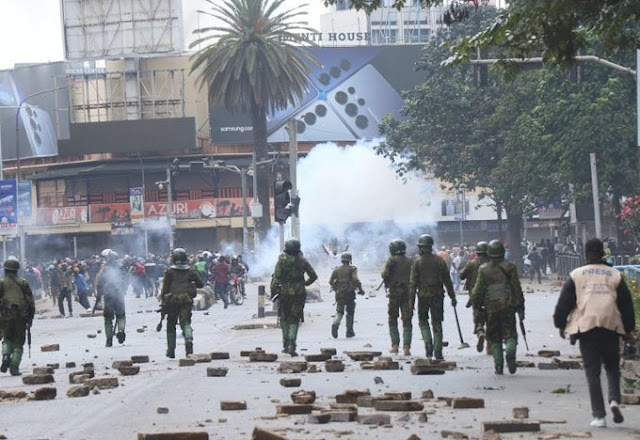By Jaymo Wa Thika
Thirty-five years ago today, the nation boiled over with anger. What began as a call for democratic reforms turned into a violent standoff between citizens and a repressive state.
That day, July 7, 1990 known as Saba Saba is now etched in Kenya’s political memory as a turning point.
🔥 The Day Kenya Defied President Moi
In 1990, Kenya was under the grip of President Daniel Arap Moi's authoritarian regime. Since the early 1980s, Kenya had been a de jure one-party state after Section 2A of the Constitution was amended in 1982. KANU (Moi’s party) became the only legal political party, criminalising any political opposition.
During that period, Kenya was plagued by political repression, torture and detention of dissidents without trials, censorship of media, corruption and economic inequality.
But on July 7th, prominent politicians Kenneth Matiba, Charles Rubia, and Jaramogi Oginga Odinga, among others defied this silence. They had called for a mass rally at Kamukunji Grounds in Nairobi, demanding the return of multi-party democracy by repealing Section 2A of the Constitution, free and fair elections, the respect of human rights, and an end to political persecution.
The government responded with brute force. The rally was banned and key organisers like Matiba and Rubia were arrested days before the event. However, thousands of Kenyans, especially the youth, poured into the streets. The city exploded.
Police and paramilitary forces used live bullets, teargas, and brutal force to disperse crowds. Protesters, armed with stones and voices, fought back. What followed was a multi-day battle, with parts of Nairobi, Kisumu, and Mombasa engulfed in chaos.
At least dozens were killed, hundreds injured, and over 1,000 arrested. Among the casualties was Kenya’s innocence. The violence laid bare the brutality of Moi’s rule. And it opened a wound that would change the country.
What followed was brutal crackdown and widespread fear. Major political figures detained without trial (Matiba suffered a stroke in custody).
🌱 The Fruits of Rebellion
Though the state won the physical battle, it lost the war of public perception. The intensity of the protest shocked the regime and sparked global condemnation. The crackdown drew international condemnation. Western allies, donors, and activists began pressuring Moi’s regime for change.
By December 1991, Moi bowed to pressure and repealed Section 2A of the Constitution, paving the way for multi-party democracy. Kenya’s first multi-party elections in 1992 were a direct result of that struggle. Saba Saba had shaken the walls of dictatorship.
⚡ Saba Saba 2025: A New Generation Rises
Fast forward to July 7, 2025. Kenya is not under a dictatorship but it faces another kind of crisis: economic suffocation, runaway corruption, and rising inequality.
Today, Gen Z protesters have reclaimed the date. Across cities and towns, a digitally-coordinated wave of demonstrations is unfolding once more reminding Kenyans that while times have changed, the spirit of resistance has not.
In June 2024, the youth many from Gen Z began organizing under the banner of #RejectFinanceBill2024. What began as a protest against punitive taxation morphed into a broader movement demanding:
• Transparent governance
• Dignified job creation
• An end to police brutality
• Inclusion of youth in decision-making, among others
Using TikTok, X (formerly Twitter), Telegram, and Instagram, this new movement has no formal leaders, no political affiliations only collective pain, and digital courage.
Today, Saba Saba 2025, thousands are planning to be back in the streets: from Nairobi’s CBD to Kisumu, Nakuru, Eldoret, Mombasa and across the country. Their chants, song, and dances all decrying the cost of living, corruption and elite impunity.
There is heavy police presence and most Kenyans expect clashes in many towns. Yet the protesters remain defiant.
📜 From Matiba to TikTok: A Common Thread of Courage
In 1990, Matiba paid with his health, suffering a stroke in detention. In 2025, activists are being abducted in unmarked cars, cyberbullied or threatened with arrest. But neither generation has bowed.
Both struggles speak to a truth many leaders try to ignore: Kenyans do not fear change. They fear oppression disguised as order.
🕊️ What Next for Kenya?
The 1990 uprising eventually delivered political pluralism. The 2025 protests may very well usher in a new social contract one where the youth are not just seen as voters, but as active architects of Kenya’s future.
Whether today’s protests succeed in their immediate goals or not, one thing is clear: Saba Saba lives on not in history books but in the chants echoing through Kenya’s streets today.
And just like in 1990, the world is watching.




No comments:
Post a Comment